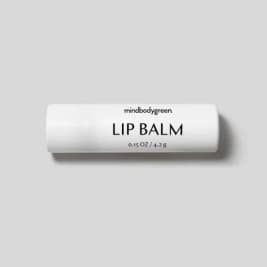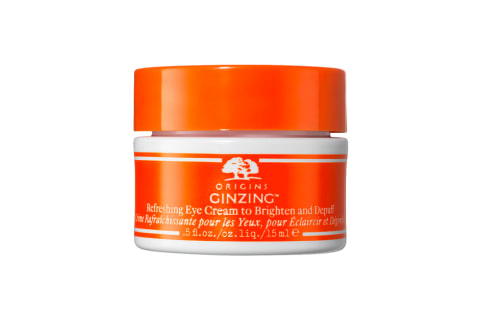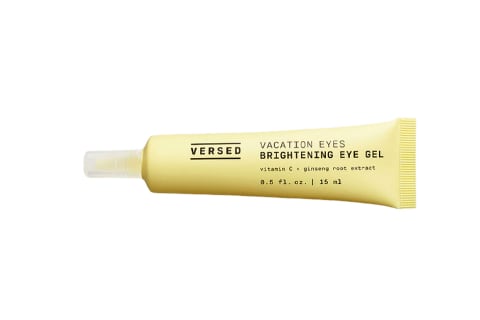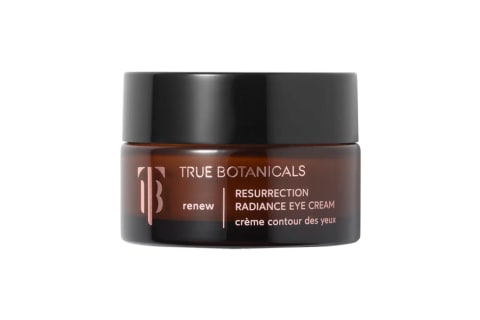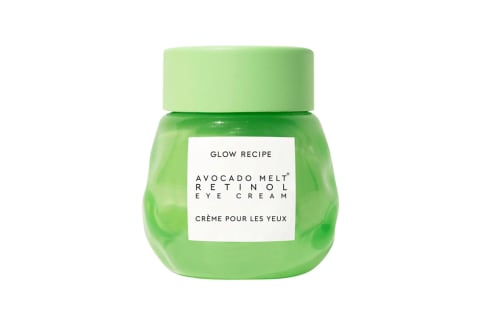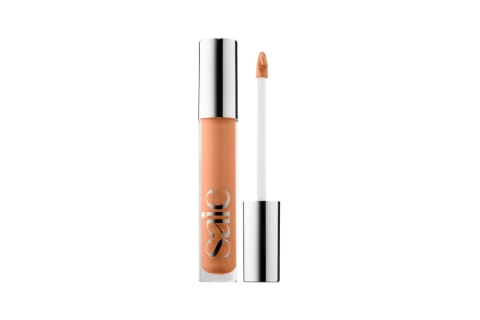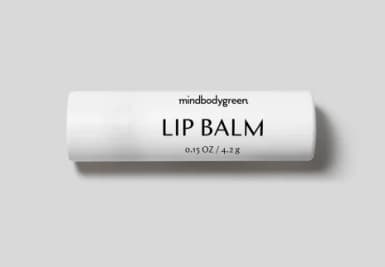Experts Explain What Causes Dark Circles + How To Deal

Endless products on the market claim to reverse dark under-eye circles or cover them up completely. Many of these products can certainly help ease the look of these shadows, but have you ever wondered why they happen in the first place?
If you feel like you've tried everything, you might want to start over with a new goal: Rather than trying every product under the sun to lighten those half-moons under your eyes, you should work to find the root cause.
Start here—experts explain the science behind why you might have dark circles and what to do about them.
What are dark circles?
Dark circles, officially called periorbital hyperpigmentation1, appear as discoloration below the eye. "This can either be due to hyperpigmentation of the skin, or thin skin that allows blood vessels and underlying tissue to show through," explains board-certified dermatologist Rebecca Marcus, M.D., FAAD.
This discoloration is starkly different from eye bags in terms of cause and appearance. Eye bags are consistent outpourings of tissue below the eye that are "usually caused by fat herniation as the tissue becomes less firm with age," Marcus says.
Dark circles are also different from general eye puffiness. "Puffy eyes usually refers to swelling around the entire eye, which may be a result of an allergy, dietary factors (salt, alcohol), illness, or other sources of inflammation," Marcus says. Some of these same factors can lead to dark circles, too—more on that below.
Causes of dark circles.
Completely getting rid of dark circles isn't always possible—but identifying what's causing yours can at least help you on your skin care journey:
Exhaustion or lack of sleep
"Poor sleep is associated with more skin dryness, which can further worsen the appearance of under-eye shadows," explains board-certified dermatologist and YouTube creator Andrea Suarez, M.D., FAAD.
So contrary to popular belief, sleep is not directly linked to dark circles but rather exacerbates their appearance. "Not getting enough sleep or poor-quality sleep may accentuate the problems that make eyes appear tired," Marcus echoes. So even if you're getting eight hours, subpar sleep quality may be to blame.
Allergies
Allergies can cause eye puffiness, along with dark circles. "Seasonal allergies and allergic conjunctivitis causing you to rub your eyes can drive more inflammation and fluid accumulation under the eyes, which worsens the appearance of dark circles," Suarez says. So if you're prone to allergies, you may want to check in with your doctor to learn about your options for managing them.
Eye strain
If you squint when you look at a screen or read, you may want to consider heading to the ophthalmologist for a checkup. "Excessive time staring at the screen may cause eye strain and subsequent engorgement of the surrounding blood vessels and, therefore, dark circles," Marcus explains. Dark circles or not, your eyes will thank you for taking breaks from the screen every now and then.
Genetics
"Genetics certainly can play a role, with some people more prone to either hyperpigmentation or under-eye shadowing as a result of the shape of the anatomy around the eye socket," Suarez tells mbg.
Skin tone
Like we mentioned, dark circles can be caused by increased hyperpigmentation—something that has a long list of initial causes. Hyperpigmentation, by definition, is when melanin in the skin is produced in excess, causing the skin to darken.
"This is particularly exacerbated by sun exposure and inflammation and tends to be more of a risk in those with darker skin tones," Marcus says about hyperpigmentation. This increase in visual hyperpigmentation in darker skin tone transfers over to sun spots, dark spots caused by breakouts, and so on.
Age
"With age, collagen and elastin loss3 leads to thinner skin, making shadows more obvious," Suarez says. These same factors lead to crepey skin, fine lines, and wrinkles alike.
As your collagen decreases, you may consider supplementing to level out the production and degradation—here's everything you need to know about starting the process.
Health conditions
Suarez notes that medical conditions can also lead to dark under-eye circles. A few common examples include anemia, hypothyroidism, poor nutrition, malabsorption syndromes, and certain metabolic syndromes.
Dehydration
If you needed another reason to keep up with adequate hydration, let it be this: "If you are dehydrated, this can cause the tissues of the body to shrink, including under-eye skin, making dark circles look more noticeable," Suarez says.
A lack of adequate water consumption has been linked to an increase in skin dryness4 overall, so a few extra cups will do much more for your skin (and full-body) health than prevent dark circles. In addition alcohol can also dehydrate the skin, so its important to drink in moderation.
What to do about dark circles.
Understanding your skin is the first step toward caring for your skin. Now that you know more about the causes, let's get into solutions, shall we?
Use eye cream daily.
Like we mentioned previously, dry skin around the eyes can lead to more prominent dark circles. In order to keep the skin nourished, hydrated, and protected, you may consider adding an eye cream to your skin care lineup.
A few ingredients Marcus suggests looking out for in your next eye cream include caffeine, niacinamide, peptides, hyaluronic acid, and gentle retinol.
Not sure where to look? We searched high and low for the very best creams for dark circles—here are our top 18 picks. You can also opt for eye masks for quick pick-me-ups.
Master under-eye concealer.
You can't change many of the causes listed above, so concealer may be your best bet at managing your dark circles. Once you find a concealer you swear by (here are a few A+ options), follow these application tips to use it right for every purpose—nixing dark circles included. And if you're dealing with puffy eyes and dark circles, these tips can help.
Get enough high-quality rest.
If a lack of high-quality sleep can lead to dark circles, that means adequate rest just might do the trick. Improving the quality of your sleep is no easy task, especially given the fact that there's a plethora of causes for the lack of shut-eye.
If you're on the path to sleeping better, check out these 15 tips to improve the quality of your slumber.
Drink more water.
Now you know that dehydration contributes to dry skin and may even lead to more prominent dark circles because of that. Consuming enough water comes more easily to some but can be a stressful task for others.
If you're not sure where to start, we asked experts for their best hydration tips—here's what they said.
Consult a health care practitioner.
Even if you drink your daily dose of H2O, get high-quality rest, and use eye cream, your dark circles may be coming from something else that might not offer a quick fix. It's important to consult your doctor about severe, unchanging dark circles as they may be a symptom of a larger, full-body health concern. As Suarez says, "If your dark circles persist, it is always a good idea to have an annual checkup with your doctor, including a physical exam and blood work, if necessary."
Prevention tips:
As a general rule in skin care: It is always easier to prevent than treat. Well that goes for dark under eye circles as well. Along with the remedies above, here some ways to help keep the appearance of dark circles minimal.
It’s important to note that dark circles are often genetic. So it’s not always possible to avoid them entirely. However, most of these tips are just good skin care and health care practices in general, so worth following regardless.
- Use sunscreen: Sun damage can not only increase pigmentation in the skin, but it can also thin out the density—two causes of dark under eye circles.
- Load up on antioxidants. Using topical antioxidants is always beneficial for skin, no matter if your concerns are fine lines, dullness, sagging, or pigmentation. They work best if you use them consistently and long term, as they’ll not only address the dark circles you have, but can help prevent the formation down the line.
- Use a retinol eye cream. While some folks find retinol hard to tolerate, it can be hugely beneficial for addressing under eye circles as it can ease hyperpigmentation and improve dermal density. Like antioxidants, it’s best to start using it as a preventative measure.
Best products for dark under eye circles
Quick at-home remedies:
There are many ways to help improve the appearance of your dark circles, that range from professional intervention to DIY remedies. For those who prefer to stay on the latter end of that spectrum, here are ideas to give a go.
- Tea bags. Caffeine is a vascular constrictor, which means it minimizes fluid pooling in the area. This can limit puffiness, as well as dark circles (as one cause of dark circles is blood showing through the thin skin). In addition tea is high in antioxidants, which has anti-inflammatory and brightening properties. Simply brew your tea, cool, and then place the bags over your eyes for a few minutes. Opt for options such as green, black, white, and oolong.
- Cold compress. Ice rollers, chilled spoons, and frozen fruits or juices (such as cucumber or aloe) can all help give your eyes a quick pick-me-up. Cool temperatures constrict the circulation, limiting flow to the area and reducing the pigmentation that comes with it. Check out our favorite ice rollers here.
- Gentle massage. With your fingers or a roller, gently massage the area while applying your eye cream. This can help improve drainage, reducing any pooling in the area.
- Aloe vera. One of the most impressive DIY ingredients also helps with hyperpigmentation and under eye circles. One study found that the topical application of aloesin can directly inhibit hyperpigmented skin.
What about under eye fillers?
Your skin and body are yours to make choices about however you see fit. This is a judgment free zone! But before you make any decision about injectables, minimally invasive, or surgical procedures, you should be well informed.
And many folks are curious what sort of professional intervention can help them address dark circles—most notably, can filler help? The answer is dependent on several factors.
First, filler (called tear through filler) can only help if your dark circles are caused by density loss in the area, not due to pigmentation. “There are many causes for discoloration under the eyes, and one of them is hollowing or loss of volume. This leads to a depressed ‘tear trough’, which is a groove between the lower eyelid and cheek, and can contribute to a tired appearance,” explains board-certified dermatologist Brian Hibler, M.D., of Schweiger Dermatology Group in New York City.
For example, a good candidate may be someone whose eye area appears sallow, which casts shadows in the area. By strategically injecting hyaluronic acid filler into the area, it smooths out the skin, reducing shadows.
It’s very important to note that this type of filler requires a more skillful hand than other areas might. This is because it comes with notable risks: “The major risks are bruising and swelling, with less common risks including infection or nodule formation. If the filler is inadvertently injected into one of the blood vessels it can cause necrosis (death) of the overlying skin or can cause occlusion of the blood vessels leading to the eye and result in blindness,” says Hibler. “Therefore, it is important to see a board-certified dermatologist with appropriate training in safely performing these procedures.”
It’s also a more challenging injection method. As Hibler explains, “It is typically performed using a cannula (long, flat-topped tube) to thread the filler into the hollowed area using a small insertion point in the mid-cheek. Some injectors opt to use a needle in this location, however, a series of needle punctures could lead to more bruising and increase the risk of inadvertent injection into one of the blood vessels.”
So you should find a board-certified aesthetic dermatologist or surgeon. We should also add that you should find a professional who is experienced in this specific area. Some injectors are better at lips, cheeks, etcetera—find one who knows the area well.
FAQ
What deficiency causes dark under eye circles?
According to board-certified dermatologist Andrea Suarez, M.D., FAAD poor nutrition, deficiencies, and malabsorption syndromes can contribute to dark under eye circles. Some of the more common deficiencies include iron, vitamin B12, E, K and D.
How do you fix dark circles?
Fixing dark circles first requires identifying the root causes (or causes), and addressing those, be that lack of sleep, nutrition, stress, or allergies. However, some of the causes of dark circles can’t be changed, such as genetics and natural pigmentation. However, you can ease the appearance with topical measures such as eye creams (look for those that contain caffeine, niacinamide, peptides, hyaluronic acid, and gentle retinol) or concealer. For more permanent measures, consult your dermatologist.
Can dark circles go away?
If dark circles are caused by dehydration, nutrition, stress, allergies, and lack of sleep, then yes it’s possible to address their appearance through lifestyle changes. However, many folks’ dark circles are caused by genetics or pigmentation so those can never fully go away, but can be eased through dermatological intervention.
The takeaway.
The best way to treat dark circles is to look for the root cause. A few reasons your under-eye shadows may be especially noticeable include exhaustion, allergies, dehydration, age, skin tone, and genetics. Health conditions can also cause dark under-eye shadows, which is why you may want to consult your doctor if your eye shadows are persistent. Again, dark circles are different from eye bags—here's a breakdown on the latter if you're curious.

Hannah Frye is the Assistant Beauty & Health Editor at mindbodygreen. She has a B.S. in journalism and a minor in women’s, gender, and queer studies from California Polytechnic State University, San Luis Obispo. Hannah has written across lifestyle sections including skin care, women’s health, mental health, sustainability, social media trends, and more. She previously interned for Almost 30, a top-rated health and wellness podcast. In her current role, Hannah reports on the latest beauty trends and innovations, women’s health research, brain health news, and plenty more.
